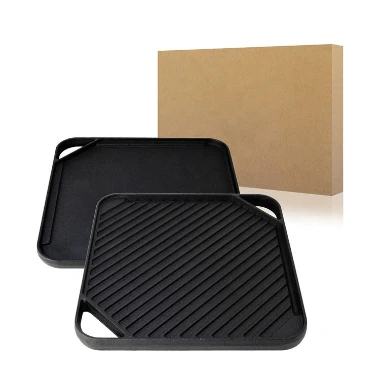
what is a dutch oven made out of
A Dutch oven is a versatile and essential piece of cookware found in many kitchens around the world. But what exactly is it made of? Understanding the materials used in Dutch ovens can help you choose the right one for your cooking needs and can also shed light on how it functions so effectively in a variety of cooking methods.
Traditionally, a Dutch oven is constructed from cast iron, a durable material that has been used for centuries. Cast iron is known for its excellent heat retention and distribution properties, making it ideal for slow cooking, braising, baking, and even frying. The heavyweight of the cast iron helps maintain consistent temperatures, which is crucial when simmering stews or baking bread. Furthermore, cast iron Dutch ovens are often coated with a layer of enamel, which adds several advantages it prevents rusting, simplifies cleaning, and eliminates the need for seasoning that bare cast iron requires.
Enameled cast iron Dutch ovens are particularly popular because they come in various colors and styles, allowing them to double as attractive serving dishes. The enamel surface is non-reactive, meaning it won’t interact with acidic foods, which can be an issue with bare cast iron. This makes it perfect for cooking tomato-based sauces or dishes with vinegar. However, care must be taken to avoid chipping the enamel, as it can affect the performance and longevity of the cookware.
While cast iron is the classic material for Dutch ovens, other materials are also available on the market. Some manufacturers produce Dutch ovens made from aluminum, which is lighter than cast iron and heats up more quickly. However, aluminum can also warp over time and may not retain heat as well as cast iron, making it less ideal for slow cooking.
what is a dutch oven made out of

Additionally, there are stainless steel Dutch ovens. These typically feature a thicker base to promote even heating and are highly resistant to rust and staining. They often come with a non-stick ceramic coating, which can provide an easy cooking experience, though they might not have the same heat retention qualities as cast iron options.
Finally, there are modern variations like those made from ceramic or stoneware, which are often used for baking dishes but can function similarly to Dutch ovens in terms of their shapes and cooking capabilities. However, these may not offer the same versatility or heat management as their cast iron counterparts.
In conclusion, Dutch ovens are primarily made of cast iron, often with an enamel coating for enhanced performance and aesthetics. While alternatives exist, the classic cast iron design remains the gold standard for its superior heat retention, even cooking, and durability. Whether you are a novice cook or a seasoned chef, investing in a quality Dutch oven can elevate your culinary creations and provide reliable performance for years to come.
-
Season Cast Iron Perfectly with GPT-4 Turbo TipsNewsAug.01,2025
-
High Quality Cast Iron Cookware - Baixiang County Zhongda MachineryNewsAug.01,2025
-
Premium Cast Iron Pan: Durable & Perfect HeatNewsAug.01,2025
-
High Quality Kitchen Durable Black Round Cast Iron Cookware Pancake Crepe Pan-Baixiang County Zhongda Machinery Manufacturing Co., Ltd.NewsAug.01,2025
-
Cast Iron Cookware - Baixiang County Zhongda Machinery | Nonstick, Heat ResistanceNewsAug.01,2025
-
High Quality Kitchen Durable Black Round Cast Iron Cookware - Baixiang County Zhongda Machinery | Non-Stick, Heat Retention, DurableNewsJul.31,2025


